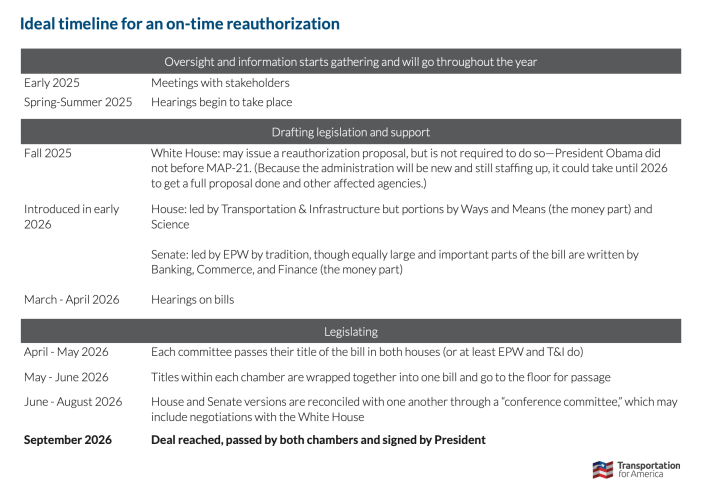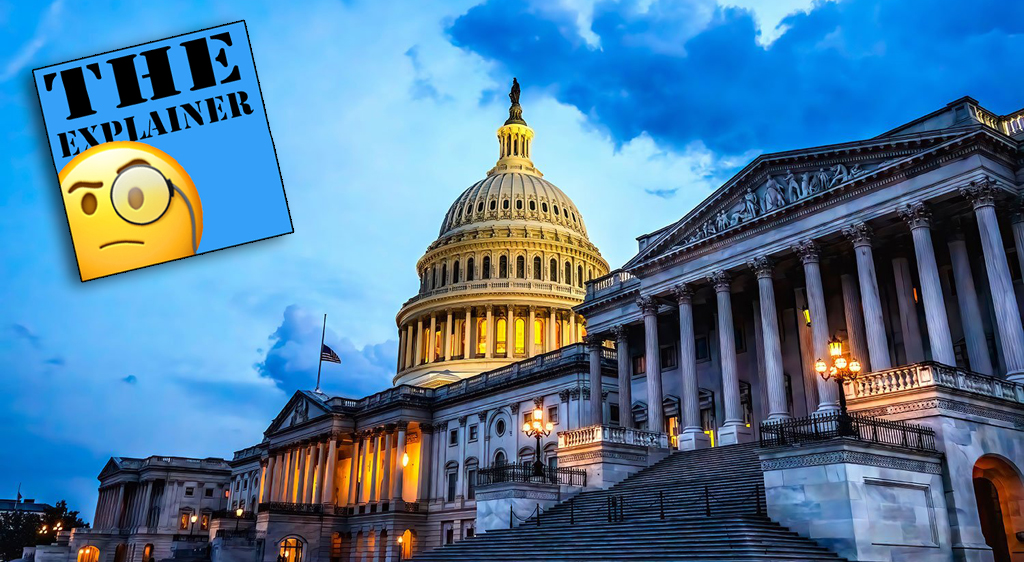The U.S. Department of Transportation just held a kick-off event for the next surface transportation reauthorization — but what does that term actually mean?
Before we fully embark on yet another Infrastructure Week Year Eon, we thought we'd take a few moments to answer the basic questions about how America passes its most important (and gigantic) federal transportation bill — and help advocates work for a better one this time around.
Explain it to me like I'm 12: What is the surface transportation bill, and why should it matter to me?
Basically, every five years, Congress is supposed to pass one big bill covering pretty much everything about how the federal government does roads, bridges, rail, transit, bike lanes, sidewalks, and more. (The "more" includes pipelines, ferries, and airports, but we don't worry about that stuff much at Streetsblog.)
And because the federal government has historically supplied about one-quarter of all money for transportation and water infrastructure across the country — and a lot of the money for the most transformative infrastructure, like highways that destroy neighborhoods and big transit projects that connect them — this bill is particularly important to how America moves day to day.
When all is said and done, the surface transportation bill will probably clock in north of 1,000 pages, and will dictate which federal transportation grant programs get renewed, created, or cut, what requirements grantees have to meet (or don't have to meet), and where that money will come from.
That's critical stuff that will have a direct impact on how your city looks for the foreseeable future — and because federal matching funds are so important to state and local transportation projects, it will set the tone for how your community spends its money, too.
Why is it called a "reauthorization?"
Because Congress doesn't like to start from scratch over and over, they call the legislative process of creating this bill a "reauthorization" of the existing law, even if the new bill looks very little like the last one and a lot of programs, policies, and funding levels change.
Historically, though, virtually every surface transportation bill has had a few things in common: they've pretty much all prioritized cars over transit, biking, or walking, put new construction over fixing the stuff we already have, and emphasized drivers' speed over everyone's safety.
Hold on, why did you say at the beginning Congress is "supposed" to pass this big, new bill every five years?
Because lawmakers usually miss their deadline.
Since they can't agree on what America's transportation future should look like, Congress has rarely managed to get enough votes to finish the reauthorization process by the time the last law expires, which usually means the legislature has to pass a short-term extension (or two, or 10) to keep the federal transportation dollars flowing.
That could mean that we'll be stuck with the current law, the Bipartisan Infrastructure Law, for a while — unless opponents of that law get really organized.
Wait; I thought the current law was called the Infrastructure Investment and Jobs Act?
Officially, it is! But because everything in this process has to be as confusing as possible, our current surface transportation bill has a nickname, too — just like the surface transportation bill is often colloquially called the "infrastructure law" even though it does a lot more than just build infrastructure, the surface transportation reauthorization is often called just "the reauthorization," and about a million other terms and synonyms that are tough for an average person to keep up with.
Moral of the story: never be ashamed to ask a wonk to clarify what he or she means when using a reauthorization-related term that you're not familiar with. It's your right to understand this stuff and participate in conversations about it, even if you're not an expert — because it's your community that will be reshaped by these policies.
Phew. So what's up with the Bipartisan Infrastructure Law/BIL/Infrastructure Investment and Jobs Act/IIJA/whatever the heck our current surface transportation bill is called?
The Bipartisan Infrastructure Law (we'll stick with that name for now) is set to expire on Sept. 30, 2026.
Even back when it was passed in 2021, the BIL has been controversial among transportation reformers like Beth Osborne of Transportation for America, who at the time condemned it for "providing hundreds of billions for status-quo programs that will be used to build new roads and produce ever-increasing emissions," even though it also included more discretionary programs for climate mitigation than ever.
Many Republicans didn't like it either, in part because it contained programs for climate mitigation, which they considered wasteful, as well as what they called "red tape" in the form of equity and environmental requirements on federal money that they say slowed down projects, drove up costs, and decreased states' flexibility.
When will we get a new bill to replace it?
We really don't know, but signs point to soon.
Because all three branches of government are currently controlled by Republicans, top transportation leaders like Secretary Sean Duffy and House Transportation and Infrastructure Committee Chair Sam Graves (R-Mo.) seem to be really eager to buck the trend and replace the BIL with a new law before the November 2026 midterms, rather than temporarily extend it like virtually every other surface transportation bill before it.
They and other top transportation leaders have already started hosting hearings and collecting tens of thousands of comments on what the next bill should look like — and they're ready to hit the ground running to introduce a proposal as soon as this fall, and some sections of the bill as soon as the end of the year.

So who will actually write the policies in this new monster law?
So here's where things get complicated.
Because the reauthorization touches so many big, juicy policy questions — including not just how the U.S. does "transportation" across a bunch of different modes, but how we do research, taxation, environmental stewardship, and more — seven committees (three in the House, four in the Senate) will each write sections of this bill. Then there are the sub-committees that will develop important sub-portions of those bills like the transit segment, which the advocates at Transportation for America say "are truly where the policy work begins."
T4A has a much more detailed breakdown of how all this happens in their Reauthorization 101 guide if you'd like start blocking off time to watch a zillion hearings, but we'll do our best at Streetsblog to give you the highlights as they happen (bookmark this page).
Stay in touch
Sign up for our free newsletter
But arguably, all of that will be a lot less important than the answer to one very specific policy question that Congress will have to deal with ...
Where will the money for all this stuff come from?
So here's where things get really, really, really complicated.
Again, we strongly recommend you spend some time with the incredible work of T4A to get a full understanding of this, but in the smallest possible nutshell: historically, most of the programs in the surface transportation bill have been powered by something called the Highway Trust Fund, which gets about 90 percent of its money from gas taxes, plus some spare change from things like tire fees.
That money, together with a few other revenue sources, then gets spent on all kinds of transportation projects, not just those most directly benefitting drivers, like highways — because despite what some car-brained jerks/advocates of the so-called "user pay principle" might say, getting people out of traffic jams and into buses, trains, bike lanes and sidewalks benefits motorists, too.
Non-automotive modes, though, have historically only gotten about 20 percent of the money in any given surface transportation bill, while highways gobbled up the other 80 percent. And the former, historically, has been more likely to be subject to the annual budget and appropriations process, which means it's vulnerable to getting clawed back or reduced.
So what's the problem with the way we fund transportation right now?
The problem is: Congress has refused to increase the gas tax since 1993, even as cars have gotten more fuel efficient and inflation has soared — driving down the revenue in the Highway Trust Fund by about $10 billion per year from 2010 to now. The increasing adoption of electric vehicles, meanwhile, have driven gas taxes down even further, though most experts say even charging EV drivers steep new fees won't put much of a dent in the shortfall.
That shortfall has, essentially, required taxpayers to offset our federal transportation programs' losses with massive bailouts every single year — regardless of whether they drive, and regardless of whether our car-dominated transportation system is actually working for them.
And according to Transportation for America, even if we cut every every single dollar that doesn't exclusively benefit drivers and turned the "surface transportation" bill into a straight-up highway bill — a proposal you're likely to hear some version of from a lot of people over the course of the authorization! — the Highway Trust Fund would still need bailouts of more than $20 billion per year just to break even.
And we'd also have a transportation system that's even more deadly, polluting, destructive, and impossible to access for those who can't drive than it is right now ... which would be insane.
That's why, for a lot of transportation reform advocates, the single biggest question of the next reauthorization is, "Should we keep doing that we've always done and try to win more money for shared and active transportation programs — even if politically, that will mean passing bills that also guarantee sending endless boatloads of cash straight to highways? Or should we take a step back, stop shoveling dollars into a broken transportation system, and try something radically new?"
This is all so intimidating and huge. How can I help?
We'll figure it out together.
Throughout our coverage of the surface transportation reauthorization here at Streetsblog, we'll do our best to connect you with concrete opportunities to take action to influence the trajectory of this mega-bill, and unpack what this law will mean for real communities like yours. We'll identify the big players steering the ship, decode long, wonky policies in simple terms, and let you know when there's an opportunity to call and make your voice heard, and join with other advocates to end mass car dependency to amplify a common message.
Reauthorizations are massive and overwhelming, but the movement for a better future can be, too. Let's lock in and do our best to make sure the next surface transportation reauthorization is the most transformative one yet.
Now that you're up to speed, check out our timeline of the most important moments in the journey to the next infrastructure bill.






